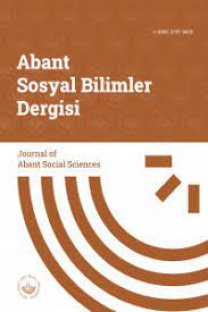Suçluların Farklılık Arz Eden Profilleri: Cinayet ve Hırsızlık Suçlarını İşleyenler Üzerine Karşılaştırmalı Bir Araştırma
Makale basılı kopyadan tarandığı için açılması bağlantı hızınıza göre farklılık gösterebilir. Makaleyi bilgisayarınıza indirmeniz tavsiye edilir.
Anahtar Kelimeler:
Adam Öldürme, Hırsızlık, Suçlu Profili
-
The opening speed of this scanned document may vary depending on your connection speed.
Keywords:
-,
___
- Akkoç, N. (2006). Namus Adına Uygulanan Şiddetin Kültürel Kaynakları”, Namus Adına Şiddet: Kuramsal ve Siyasal Yaklaşımlar İçinde (Der:
- Shahrzad Mojab ve Nahla Abdo). İstanbul: İstanbul Bilgi Üniv. Yay., ss.119— 131.
- Blau, J ., Peter, B. (1982). “Metropolitan Structure and Violent Crime”, American
- Sociological Review, n. 47, ss. 114-128
- Braithwaite, J. (1979). Inequality, Crime and Public Policy. London: Routledge ve Kegan Paul.
- Clarke, K. C. (1997). Getting Started with Geographic Information Systems. Upper Saddle River. NJ: Prentice Hall.
- Cohen,Lawrence E. ve Marcuse Felson (1979), “Social Change and Crime Rate Trends: A Routine Activity Approach”, American Sociological Review, n. 44, ss. 588—608.
- Crutchfıeld, R. D., Geerken, M. R., Gove, W. R. (1982). “Crime Rate and Social Integration”, Criminology, n. 20, ss. 46-478.
- Danziger, S., Wheler, D. (1975). “The Economics of Crime: Punishment or Income Redistribution”, Review of Social Economy, 0. 33, n. 2, ss. 113-131.
- Eisenberg, M. (1986). Release Outcome: Repeat Offenders. Austin: Texas Board of Pardons and Parole.
- Emniyet Asayiş İstatistikleri (2003), http://www.egmgovtr/asayis/istatistik.asp.
- Gillespie, R. W. (1979). "Economic Factors in Crime and Delinquency: A Critical Review of the Empirical Evidence." Report to the National Institute of Law Enforcement and Criminal Justice, Department of Justice, ss. 601— 626.
- Glock, (3. Y. (1998). Dindarlığın Boyutları Üzerine. Din Sosyolojisi içinde (Der: Yasin Aktay ve M. Emin Köktaş), Ankara: Vadi Yay., ss. 252-274.
- Hearnden, I., Magill, C. (2004). Decision Making by House- Burglars: Offenders Perspective. London: Home OfŞce.
- Howsen, R. M., Jarrell, S. B. (1987). “Some Determinants of Property Crime: Economic Factors Inşuence Criminal Behavior but Cannot Completely Explain the Syndrome”, American Journal of Economics and Sociology, n. 46, ss. 444-457.
- Hülür, H., Kalender, A. (2003). Sosyo-Politik Tutumlar ve Din: Konya Araştırması. Konya: Çizgi Kitapevi.
- İçli, T. G. (1998). Kriminoloji. Ankara: Bizim Büro Basımevi
- Jacobs, D. (1981). “Inequality and Economic Crime”, Sociology and Social Research, c. 66, n. 1, ss. 565—604.
- Kennedy, L., Forde, D. R. (1990). “Routine Activities and Crime: An Analysis of victimization in Canada”, Criminology, n. 28, ss. 137-151.
- Kawachi, I., Kennedy, B. P., Wilkinson, R. G. (1999). “Crime: Social Disorganization and Relative Deprivation”, Social.Science& Medicine 0. 48, n. 6, ss. 719—731.
- Koening, D. J., Linden, R. (2004). Conventional or Street Crime. İçinde Criminology: A Canadian Perspective (Ed. R. Linden, 408—443) Toronto: Thomson—Nelson.
- Lee, M. R. (2001). “Population Growth, Economic Inequality, and Homicide”, Abant Izzet Baysal Universitesi Sosyal Bilimler Enstitüsü Dergisi 200 7—1 (14) Deviant Behavior: An Interdisciplinary Journal, 11. 22, ss. 491-516.
- Livingston, J. (1996). Crime and Criminology. USA: Prentice — Hall.
- Myner, J ., Santman, J., Cappelletty, G. G., Perlmutter, F. B. (1998). “Variables Related to Recidivism Among Juvenile Offenders”, International Journal of Offender Therapy and Comparative Criminology, c. 42, n. 1, ss. 65—80.
- Newman, O. (1972). Defensible Space: Crime Prevention Through Urban Design. New York: MacMillan.
- Newman, 0. (1996). Creating Defensibl Space, Office of Policy Development
- and Research. Washington DC.: US Department of Housing and Urban .. Development.
- Oğün, A. (1998). “Türkiye’de Adam Öldürme Suçunda Etkili Olan Bazı Sosyal Kültürel Özelliklere İlişkin Sosyolojik Bir Araştırma”, Polis Bilimleri Dergisi, c. 2, Ankara.
- Patterson, E. B. (1991). “Poverty, Income Inequality and Community Crime
- Rates”, Criminology, c. 29, ss. 755—776.
- Pope, N. (2006). Namus Cinayetleri: Ataerkil Denetim Araçları, Namus Adına Şiddet: Kuramsal ve Siyasal Yaklaşımlar İçinde. (Der: Shahrzad Mojab ve Nahla Abdo), S. 107— 116, İstanbul: istanbul Bilgi Üniv. Yay
- Ronet, B (1991). “An Analyis of American Indian Homicide. A test of Social
- Disorganization’ and Economic Deprivation at The Reservation County
- Level”, Journal of Research in Crime and Delinquency, c. 28, n. 4, ss. 45 6— 473.
- Sheley, J. F. (1995). Criminology: A Contemporary Handbook. USA: Wadswort Pub.
- Stollard, P (ed.). (1996). Crime Prevention Through Housing Design. London: E&F N SPON.
- Williams, K. R. (1984). “Economic Sources of Homicide: Reestimating the Effects of Poverty and Inequality”, American Sociological Review, 11. 49, ss. 283 — 289.
- Williams, K. R., Flewelling, R. L. (1998). “The Social Production of Criminal Homicide: A Comparative Study of Disaggregated Rates in American
- Cities”, American Sociological Review, n. 53, ss. 421-431.
- Wolfgang, M. E., Ferracuti, F. (1967). The Subculture of Violence. Beverly Hills, Sage Pub.
- Wolfgang, M. E. (1959). Patterns in Criminal Homicide. Philadelphia: University of Pennsylvania Pres.
- Yavuz, S. (2001). Kolici Bir Seri Katilin Öyküsü. Siyah Beyaz Metis Yay.
- Yayın Aralığı: Yılda 3 Sayı
- Başlangıç: 2000
- Yayıncı: Abant İzzet Baysal Üniversitesi Sosyal Bilimler Enstitüsü
